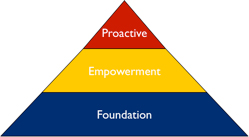Improve PSA System Adoption With Self-Service
What is self-service? Self-service means that you’re providing information to the end user that will help them meet their daily goals and manage their workload, to make them aware of where their targets are and how close they are to reaching those targets. Self-service is a focus on the end user and helping them get to where they need to be and to be successful as an individual on your team.
The 3 Levels of Self-Service

- Foundational Level – Everything always starts with a basic or a foundational level of self-service. At the basic level, the focus is on enabling the ability for people to provide needed information. For example, make it easy for individual team members to enter time and expense against projects they are assigned to.
- Empowerment Level – In the empowerment level, we help users take more responsibility, more ownership. To be empowered means users can view personal goals and their progress toward those goals such as viewing utilization target achievements and assigned to.
- Proactive Level – To be proactive means providing information to users for action. In this level individuals are given visibility into what type of projects are coming in order to take proactive steps to contribute to the performance of the company. Proactive users can view upcoming projects, perform self-scheduling to projects and tasks, and see team schedules to assist people who are over-extended, essentially doing a form of resource leveling.
Adoption Requires Accuracy
You can only be successful in implementing and using a PSA system if you keep the data clean. Keeping the data clean means having adequate control of data entry and maintenance, but it also involves compliance with the processes that you are running in the organization. A crucial step to keeping data clean is setting up reports in your PSA system to audit the data entry and quality. Nothing tells a story more than a report.
Communicate the importance of accurate data and what the compliance processes are as you develop your self-service strategies.
Dependencies and Controls
Dependencies and controls involved in self-service strategies differ depending on which level of self-service you’re concentrating on. At the foundational level, your goal is to make it easy for the user to complete required tasks. to achieve this you may limit user access to only project work they are scheduled to deliver and ensuring schedules are updated in a timely manner. At the empowerment level, you will want to identify measurable targets or goals that are visual in your PSA system and support self-service dashboards or reports to encourage users to reach those goals. Keeping targets and goals realistic, visible, and accurate will encourage process compliance to see timely progress reflected.
Finally, at the proactive level, you would ideally be providing information that allows the user to make decisions, such as including team scheduling views and on-demand pipeline or forecast data. Users in a proactive self-service strategy require more training and awareness of the do’s and don’ts of being proactive. DO schedule yourself for tasks that align with your skillset. DON’T schedule yourself for 120 hours a week of work. Controls at this level are designed to give people the ability to self-assess and make decisions, such as updating their own scheduling information, in a trusted team environment.
Successful Adoption through Self-Service
Successful adoption of PSA solutions requires user buy-in and adoption. Think about the “what is in it for me” benefits of PSA for the user. Focus on ease of use, and whenever you can, give users the ability to take control of their own progress toward their goals.
You can learn more by watching our webinar “Empower Your PSA Users with Self-Service” or find other helpful tips in our Resource Library at https://topstepllc.com/resource-library/.
